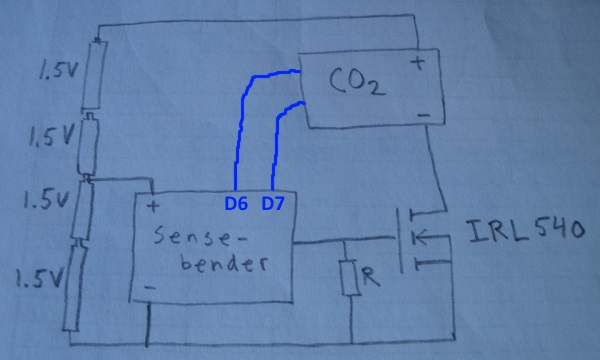Gas (Co2) sensors on batteries
-
The circuit diagram that I posted above did not show communication lines between the K-30 and the sensebender. These are included here:

However, I now realise that the K-30 and the sensebender cannot be connected this way because the sensebender (ATmega328P) digital inputs do not accept voltages higher than Vcc + 0.5V.
Does anyone have a suggestion how this problem can be solved?
@alexsh1 As you can see my experiments with powering the K-30 from batteries are not going that well...
-
The circuit diagram that I posted above did not show communication lines between the K-30 and the sensebender. These are included here:

However, I now realise that the K-30 and the sensebender cannot be connected this way because the sensebender (ATmega328P) digital inputs do not accept voltages higher than Vcc + 0.5V.
Does anyone have a suggestion how this problem can be solved?
@alexsh1 As you can see my experiments with powering the K-30 from batteries are not going that well...
@arraWX OK, found an excellent sensor. The only problem is price - one has to pay for a precise sensor with ultra low power consumption.
Linearity:Nonlinear (% F.S.)
Sluggish:None (% F.S.)
Repeatability:Standard (% F.S.)
Sensitivity:High sensitivity
Drift:No
Resolution:High Resolution
MH-Z19-W01-GSS-COZIRCarbon dioxide sensor
Ultra-low-power carbon dioxide sensor
MH-Z19-W01-GSS-COZIR carbon dioxide sensor (hereinafter referred to as COZIR) COZIR is an ultra-low power consumption (3.5mW), high-precision carbon dioxide sensor, ideal for battery-powered portable instruments and equipment. Based on IR LED, detector technology and patented optical detection cavity, so COZIR become the lowest power NDIR sensor, optional temperature and humidity testing. GSS is carbon dioxide detection infrared LED leader in the field, COZIR GSS company is the third generation of products.
COZIR Ambient measurable range 0 ~ 2000PPM, 0 ~ 5000ppm and 0 to 1 percent, and is suitable for building control such as gardening and other occasions.
Ultra-low-power 3.5MW
Measuring range: 0 to 1%
Low noise measurement (<10PPM)
3.3V power supply
peak current is only 33 mA
Temperature and humidity output optional -
@arraWX OK, found an excellent sensor. The only problem is price - one has to pay for a precise sensor with ultra low power consumption.
Linearity:Nonlinear (% F.S.)
Sluggish:None (% F.S.)
Repeatability:Standard (% F.S.)
Sensitivity:High sensitivity
Drift:No
Resolution:High Resolution
MH-Z19-W01-GSS-COZIRCarbon dioxide sensor
Ultra-low-power carbon dioxide sensor
MH-Z19-W01-GSS-COZIR carbon dioxide sensor (hereinafter referred to as COZIR) COZIR is an ultra-low power consumption (3.5mW), high-precision carbon dioxide sensor, ideal for battery-powered portable instruments and equipment. Based on IR LED, detector technology and patented optical detection cavity, so COZIR become the lowest power NDIR sensor, optional temperature and humidity testing. GSS is carbon dioxide detection infrared LED leader in the field, COZIR GSS company is the third generation of products.
COZIR Ambient measurable range 0 ~ 2000PPM, 0 ~ 5000ppm and 0 to 1 percent, and is suitable for building control such as gardening and other occasions.
Ultra-low-power 3.5MW
Measuring range: 0 to 1%
Low noise measurement (<10PPM)
3.3V power supply
peak current is only 33 mA
Temperature and humidity output optional -
@alexsh1 at that prize you could buy a few Netatmo additional indoor modules. Might be that the sensor you suggested would be allot more accurate though.
@korttoma Yes, I know what you are saying, but Netatmo is not precise. I have MH-Z14 showing 750ppm and Netatmo 1100ppm, for example. I think Netatmo is using index.
All I can say that a calibrated low power CO2 sensor is very expensive. Probably for a home use you do not need to know the exact number. Personally, I have MH-Z14 - it is reasonably expensive and very accurate.
-
I have a MH-Z14 on the way with the slow boat from china, looking forward to testing it.
-
@korttoma I got mine a month ago from China. I think it can be used with batteries, but it has to be something like 18650 3000mAh to last longer.
@alexsh1 I was not planing on using it on batteries'. I now have an MQ-2 sensor in the ventilation fresh air intake to detect smoke but it has proven to be unreliable so I thought id try the MH-Z14 instead. Sometimes smoke comes in through the ventilation an then I want it to turn off automatically.
-
@alexsh1 I was not planing on using it on batteries'. I now have an MQ-2 sensor in the ventilation fresh air intake to detect smoke but it has proven to be unreliable so I thought id try the MH-Z14 instead. Sometimes smoke comes in through the ventilation an then I want it to turn off automatically.
-
I received my MH-Z14 yesterday hocked it up on a breadboard to test it and it seems to be working as expected. Now I need a more permanent setup so I can test and compare to a Netatmo indoor module. I may add an SI7021 to the same node.
-
I received my MH-Z14 yesterday hocked it up on a breadboard to test it and it seems to be working as expected. Now I need a more permanent setup so I can test and compare to a Netatmo indoor module. I may add an SI7021 to the same node.
